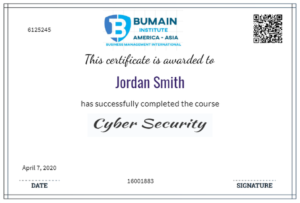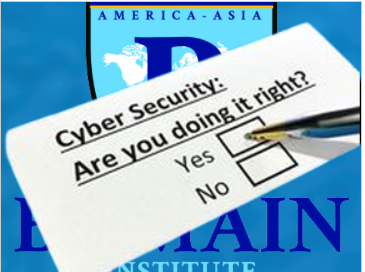
This Course is designed with these milestones in mind to achieve.
- Start strong with the foundations of computer and internet terminology ,
- Then the foundations of cybersecurity.
- You then deep dive into the different types of cyber attacks.
- As you understand the attacks you learn to design the security controls needed to build a resilient system.
- Finally, if an attack happens, you practice responding to these incidents by referring to Incident Responses
that you learn in this course. In this last section you also learn to investigate these attacks

Curriculum
- 7 Sections
- 65 Lessons
- 10 Weeks
- Section 1: Foundations of Information SecurityLearn the fundamentals of Risk Management, Cryptography, Network Security and Cloud Security. Key takeaways: Understand the “Why” behind Cybersecurity; Learn the principles of Risk Management ;Gain an understanding of how enterprise applications work ;Understand the concepts behind network design & network security; Understand how cryptography works & what it protects ;Get a flavor of perimeter-less security, also called as Zero Trust Network Architecture ;Demonstrate your understanding by completing Labs that simulate real-life scenarios14
- 1.1Lesson 1: CIA Triad
- 1.2Lesson 2: Cybersecurity Risks management
- 1.3Lesson 3: Need for Security
- 1.4Lesson 4: IAAA – Identity Authentication Authorization Auditing
- 1.5Lesson 5: Cryptography
- 1.6Lesson 6: Enterprise Applications
- 1.7Lesson 7: Network Security
- 1.8Lesson 8: OSI and TCP/IP Model
- 1.9Lesson 9: Wireshark
- 1.10Lesson 10: Zero Trust
- 1.11Lesson 11: Securing the Cloud
- 1.12Lesson 12: Security Compliance & Frameworks
- 1.13Lesson 13: Application Security (Nessus, Metasploit)
- 1.14Quiz 1Copy10 Minutes13 Questions
- Section 2: Understanding Cyber AttacksLearn about the latest advances in cybersecurity and how such attacks are managed at an organizational level.
Key takeaways:- Understand the different types of Cyberattacks and the risks they pose; Familiarize yourself with the types of threats and the threat actors; Delve deeper insight into the Tactics Techniques and Procedures (TTP) used by the adversaries; Understand the structure of an attack- Kill chain methodology; Apply the concepts of Cyberattacks and threat to discern the Solarwinds and Colonial Pipeline attacks12- 2.0Lesson 13: MITRE ATT&CK Framework
- 2.1Lesson 14: Threat Tactics
- 2.2Lesson 15: Malware
- 2.3Lesson 16: Attack Kill Chain
- 2.4Lesson 17: Attack Vectors
- 2.5Lesson 18: Deep dive into Dark Web
- 2.6Lesson 19: Physical Attacks
- 2.7Lesson 20: Indicators of Compromise
- 2.8Lesson 21: Tactics Techniques and procedures
- 2.9Lesson 22: Case Study: Not Petya Solarwinds, Colonial Pipeline, Olympic games
- 2.10Lesson 23: Attack Groups- Unit 8200, Nobelium, APT 29
- 2.11Quiz 2Copy30 Minutes14 Questions
- Section 3: Designing Security ControlsLearn how to identify and implement the right cybersecurity techniques for various cyber attacks. Key takeaways:- Understand the controls that help in detecting security threats.; Develop a deeper understanding of SIEM and its purpose.; Familiarize yourself with the reviewing, interpreting, and understanding of computer-generated logs; Learn how cyber threat intelligence helps in assessing security threats.; Gain knowledge on Network Firewall and Web application Firewall; Familiarize yourself with Antivirus and its applications; Understand and practice shell scripting.;15
- 3.1Lesson 24: Firewalls
- 3.2Lesson 25: Web Application Firewalls
- 3.3Lesson 26: IDS/IPS
- 3.4Lesson 27: Antivirus & EDR
- 3.5Lesson 28: Email Protection
- 3.6Lesson 29: Data Loss Prevention
- 3.7Lesson 30: Vulnerability Management
- 3.8Lesson 31: Zero-Day Vulnerability
- 3.9Lesson 32: Patching
- 3.10Lesson 33: System Audit
- 3.11Lesson 34: Maintenance, Monitoring, and Analysis of Audit Logs
- 3.12Lesson 35: SIEM (Security Information and Event Management)
- 3.13Lesson 36: Incident Investigation
- 3.14Lesson 37: Threat Intelligence
- 3.15Quiz 340 Minutes11 Questions
- Section 4 : Security Operations & Incident ManagementLearn to use Incident Response Playbook to defend against an ongoing cyber attack, and protect critical digital resources in this situation. Key takeaways: Learn how to read, write and examine incident reports.; Learn about the Incident response lifecycle of NIST; Familiarize yourself with the concept of the Golden hour.; Understand how to examine incident data in order secure from cyber threats using forensics; Gain knowledge on the tasks performed at a Security Operations Center (SOC); Learn to form a recovery strategy from a cyber-attack;11
- 4.0Lesson 35: Incident Response and playbooks
- 4.1Lesson 36: NIST Framework
- 4.2Lesson 37: The Golden Hour
- 4.3Lesson 38: Log and Email analysis
- 4.4Lesson 39: Writing Incident Reports
- 4.5Lesson 40: Security Operations Centre – A Deep dive
- 4.6Lesson 41: SLAs KRIs, KPI
- 4.7Lesson 42: Maintenance, Monitoring, and Analysis of Audit Logs
- 4.8Lesson 43: Recovery from an Incident
- 4.9Lesson 44: Forensics
- 4.13Quiz 4Copy10 Minutes15 Questions
- Section 5 : Preparing for Security+Prepare yourself for the CompTIA Security+ certification exam. Key takeaways:- Prepare for the Security+ exam by learning about the key concepts.; Get complete coverage of the domains measured in the Security+ Examination; Attacks, Threats and Vulnerabilities; Architecture and Design; Implementation; Operations and Incident response; Governance, Risk and Compliance; Recap the concepts learned in the mandatory modules with a specific focus on the Security+ certification exam; Utilize the question bank for practicing important concepts;10
- 5.0Lesson 48: Threat actors, vectors and intelligence sources
- 5.1Lesson 49: Attack Indicators
- 5.2Lesson 50: Vulnerability assessments
- 5.3Lesson 51: Implementing security concepts in an enterprise environment
- 5.4Lesson 52: Authentication and authorization design concepts
- 5.5Lesson 53: Implementing secure protocols, secure network designs and application security solutions
- 5.6Lesson 54: Regulations, standards and frameworks for organizational security posture
- 5.7Lesson 55: Risk management processes
- 5.8Lesson 56: Data privacy concepts
- 5.12Quiz 5Copy20 Minutes12 Questions
- Section 6 : Self-Paced Module - Demystifying ChatGPT and ApplicationsGain an understanding of what ChatGPT is and how it works, as well as delve into the implications of ChatGPT for work, business, and education. Additionally, learn about prompt engineering and how it can be used to fine-tune outputs for specific use cases.9
- 6.0Lesson 60: Overview of ChatGPT and OpenAI
- 6.1Lesson 61: Timeline of NLP and Generative AI
- 6.2Lesson 62: Frameworks for understanding ChatGPT and Generative AI
- 6.3Lesson 63: Implications for work, business, and education
- 6.4Lesson 64: Output modalities and limitations
- 6.5Lesson 65: Business roles to leverage ChatGPT
- 6.6Lesson 66: Prompt engineering for fine-tuning outputs
- 6.7Lesson 67: Practical demonstration and bonus section on RLHF
- 6.9Quiz 6Copy20 Minutes13 Questions
- Section 7: Capstone Project :Demonstrate your learnings throughout the program with a comprehensive capstone project. Key takeaways:- The Capstone project challenges you to demonstrate your skill & knowledge; You will use a combination of Hands-on skill and security research capability;1
Instructors
FAQs
There are no prerequisites required to learn this course. Any person Enthusiastic enough can enroll in this course.
cyber security doesn't require you to have technical knowledge from the get-go. Being a beginner is perfectly okay; you will learn as you begin the program.
You can study at your own pace.
On average it will take between six months and two years to learn about cybersecurity. If only a basic understanding is needed, a six-month intensive study may suffice
Yes, You will have lifetime access to this course.
As long as internet connected devices exist, cybersecurity professionals will be in demand. This means high job security as more and more devices are added to the internet. Therefore learning cyber security is worth it
According to some reports , Employer demand for cybersecurity workers grew 2.4 times faster than the overall rate across the U.S. economy in 2022
Confidentiality, integrity and availability, also known as the CIA triad, is a model designed to guide policies for information security within an organization. The model is also sometimes referred to as the AIC triad (availability, integrity and confidentiality) to avoid confusion with the Central Intelligence Agency. Although elements of the triad are three of the most foundational and crucial cybersecurity needs, experts believe the CIA triad needs an upgrade to stay effective.
The CIA triad goal of confidentiality is more important than the other goals when the value of the information depends on limiting access to it. For example, information confidentiality is more important than integrity or availability in the case of proprietary information of a company
Identification is what happens when a user claims an identity, and the process starts for authentication, authorization, and accountability for that user. A user may identify a number of ways, including typing in a username, swiping a card, or scanning his thumb.
Authentication factors can be classified into three groups: something you know: a password or personal identification number (PIN); something you have: a token, such as bank card; something you are: biometrics, such as fingerprints and voice recognition.
A security compliance program is the policies, procedures, and processes an organization creates to maintain security standards, typically based on regulatory frameworks such as HIPAA or recognized industry standards such as SOC 2
Some examples of regulatory compliance regulations include The U.S. Health Insurance Portability and Accountability Act of 1996 (HIPAA), the Sarbanes-Oxley Act of 2002, and the European Union's General Data Protection Regulation of 2016 (GDPR)
The Computer Fraud and Abuse Act (CFAA), 18 U.S.C. 1030, outlaws conduct that victimizes computer systems. It is a cyber security law. It protects federal computers, bank computers, and computers connected to the Internet.
Requirements
- Learners need to possess an understanding of the English language
- No Information Technology Knowledge Experience Necessary
- The willingness to Learn at Your Own Pace Online
- Full Internet Access to be able to learn from any location globally
Features
- Install, configure and deploy public key infrastructure and network components while assessing and troubleshooting issues to support organizational security Improved Computer Data Security
- Make sure you are implementing Better Regulatory Compliance in your organization using suitable hardware and software
- Learn how to design security architecture and framework for a secure IT operation
- Learn to Master advanced hacking concepts to manage information security efficiently
- Learb how to Frame cloud data storage architectures and security strategies, and utilize them to analyze risks
- Learn how to Protect data movement, perform disaster recovery, access CSP security and manage client databases
- Learn how to Install, configure and deploy public key infrastructure and network components while assessing and troubleshooting issues to support organizational security
- Learn how to Avoid the risks of phishing attacks by adhering to ethical security behavior
- Learn and Understand the legal requirements, privacy policies, and auditing process of your cloud environment
Target audiences
- Computer end-users who use cyber infrastructure to conduct their business
- Technical People that are responsible for parts or all of the infrastructure and the services that this infrastructure provides.
- People in different levels of management
- All levels of IT auditor/penetration tester
- Security consultants/managers
- Information Technology directors/managers/consultants
- Internet Security auditors/architects
- Security systems engineers
- Chief information security officers (CISOs)
- Chief compliance/privacy/risk officers
- Network specialists, analysts, managers, architects, consultants or administrators
- Technical support engineers and Systems analysts or administrators

